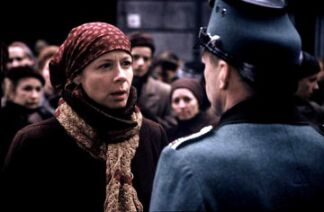Husbands and Wives
The American Spectator.
August 31, 2004.
|
As chance and the unpredictable scheduling of criticsí screenings would have it, I sat down to watch Rosenstrasse by Margarethe von Trotta just about 13 hours after I had got up from a screening of Paul Rudnickís and Frank Ozís remake of the 1975 classic The Stepford Wives, even though the former was supposed to have opened seven weeks after the latter. It struck me as an interesting pairing because the two represent opposite and contradictory extremes in the moviesí treatment of marriage. Sometimes, that is, we continue to find it convenient to treat marriage as it has generally been treated in classic literature, and especially in romantic comedy, namely as the image of earthly felicity, the end of all stories in which boy meets girl, boy loses girl etc. ó because we are quite prepared to suspend our disbelief, forget what we know of real marriages and take it for granted that what must follow from "I do" is inevitably ". . . and they lived happily ever after."
I hope it will not be necessary to explain that this idea of marriage does not imply that the writers of romantic comedy are naÔve about real marriages. When I was a teacher, it was not unusual for classes studying, say, Shakespeareís Twelfth Night, to want to speculate about the kind of conversations over the breakfast cornflakes that Viola and Orsino might have had after they had been ten years married. Can this marriage be saved? they wanted to know. It always seemed to me that such a turn in the discussion was fruitless and speculative and above all missed the point. Romantic comedies end with weddings, or the prospect of weddings, for the same reason that tragedies end with deaths: because these things give the appropriate meaning and fulfilment to the kind of human behavior that has gone before. We miss that if we turn instead to what we imagine might come after.
It is also true, however, that stories about marriages ó as opposed to courtships ó often borrow from romantic comedy the image of marriage as the perfected human state as their default position. The ideal makes an excellent contrasting background against which to play the drama of the real. That was the point of the original Stepford Wives. It created a caricature of the ideal (as it was still widely understood in those days) in order to show how destructive it was to real people, and especially real women. The movie was a gross libel against marriage, but one that was widely accepted at the time because of the influence of ideological feminism, which had adapted Marxist class analysis to the domestic sphere and so interpreted love and loyalty in terms of power relationships. The devotion of the robotic Stepford wives became the iconic deathís head expressing the terror felt by many women, and not only doctrinaire feminists, at the self-surrender demanded by traditional marriage.
How old hat it seems! Now the Stepford wife has become a figure of fun ó at least if we are to judge by the remake. Messrs Rudnick and Oz treat the storyís exaggeration of the1950s housewifely ideal as a sort of gay in-joke and introduce a gay man (Roger Bart) into the crinolined and scented sorority. For him, life in the midst of Stepfordian femininity is very heaven, while his animatronic version is a gay Republican candidate for the state assembly in a Brooks Brothers suit who says "I believe in Stepford, America and the power of prayer." The mock horror which this character inspires is no more to be taken seriously than Bette Midler made up to look like Donna Reed.
There is, itís true, a kind of doll-like quality to Nicole Kidmanís beauty which for just a moment almost manages to cut through the thick wrapping of irony in which the film is swathed. She looks almost as much at home as a Stepford wife as Roger Bart does. In her case, the caricature is the high-powered network executive dressed in black that she is supposed to be before her transformation. But any deeper meaning that such a curious inversion might impart to the film is lost as she and the rest of the robots are quickly hustled off the stage for a bizarrely happy ending. Donít ask me whether or not itís progress if we no longer see marriage as the death of the spirit but only as a joke.
Not that the movies, perhaps as recognizing the hopeful character of American audiences, donít continue to make appeals to an older idea of marriage as lifelong love and attachment, but there is often something a little off about such films. One such is The Notebook by Nick Cassavetes who casts his mother, Gena Rowlands, opposite James Garner as a woman lost in the mists of senile dementia. Mr Garnerís devoted husband reads to her a love story from the 1940s that turns out to be ó I donít think I can be giving away anything so clearly signaled as this is ó their own story, hoping to jog her almost expiring memory. The movieís heart is in the right place, but somehow the emotional wattage of such promising material is surprisingly low. Maybe itís because the Alzheimerís theme gives it a soap-opera-ish, disease-of-the-week feel or because the flashback story of the high born lady who falls for a boy from the wrong side of the tracks seems at once trite and remote from our own experience. Or maybe itís the lack of chemistry between this youthful version of the lovers, played by Rachel McAdams and Ryan Gosling. They never really have a chance to grow up but go from puppy love, almost, to extreme old age without anything in between to account for the strength of the tie between them. The result is a feeling of glib sentimentality rather than a genuinely moving portrait of a marriage.
It would be nice to think that for such a portrait we werenít driven to the Holocaust, every artistís all-purpose background setting to impart weight and seriousness and reality to his material. But we must take our watchable movies as we find them, and thatís how we find Rosenstrasse, the Movie of the Month. It helps, too, that it is based on a true story of a group of Aryan women married to Jewish men who, when their formerly protected husbands were arrested by the Gestapo at the beginning of 1943, stood outside the place of their detention in the Rosenstrasse, Berlin, in the dead of winter until they shamed even Goebbels (Martin Wuttke) into letting the men go back to their wives. "Give us our husbands back!" shout the women, knowing that they do so at the risk of death, and we canít help wondering a bit at ourselves for the ease with which we make the mental transition from finding it natural to regard husbands as the objects of such devotion to accepting them as the boors and tyrants that they are in The Stepford Wives. Who would want them back?
Is it just a matter of the difference in milieu? Back in 1943, in Germany as everywhere else, women had no choice but to be much more dependent on their husbands. Was then what those poor women were crying out for merely the return of their breadwinners, so that they could enjoy a better standard of living? I donít think so, though Miss von Trotta may be suggesting something of that possibility when she notices the absence of Aryan men keening for their Jewish wives. "They had their careers to think of," explains her heroine, Lena Fischer, who in old age (Doris Schade) is trying to account for the heroism of her younger self (Katja Riemann) to Hannah (Maria Schrader), the American-born daughter of a girl she had also saved. This child (Svea Lohde) had been the product of a mixed marriage who lost her own Jewish mother to the death camps after her gentile father had abandoned them. Shaken by hearing this story for the first time, Hannah asks her own fiancť (Fedja Van HuÍt) for reassurance: "Would you protect me?" she asks. Of course the question, as a mere hypothetical, can never be answered, but the film ends with a wedding which can only signify the hopefulness that Lenaís example of marital loyalty is meant to inspire in us. Maybe we can look beyond Stepford in more ways than one. 
[Top][Back]
|


